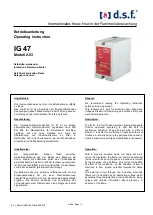
Parker Hannifin Corporation
Pneumatic Division
Richland, Michigan
www.parker.com/pneumatics
9
For inventory, lead times, and kit
lookup, visit www.pdnplu.com
Tie Rod and Profile Pneumatic Cylinders
P1F Series
Catalog 0980
Technical Data
Example
1
:
Which tube diameter should be used?
A 50 mm bore cylinder is to be operated at 0.5 m/s. The
tube length between the valve and cylinder is 2 m. In the
diagram we follow the line from 50 mm bore to 0.5 m/s and
get an “equivalent throttling bore“ of approximately 4 mm. We
continue out to the right in the chart and intersect the line for a
2 m tube between the curves for 4 mm (6/4 tube) and 6 mm
(8/6 tube). This means that a 6/4 tube throttles the velocity
somewhat, while an 8/6 tube is a little too large. We select the
8/6 tube to obtain full cylinder velocity.
Example
2
:
What cylinder velocity will be obtained?
A 80 mm bore cylinder will be used, connected by 8 m 12/10
tube to a valve with Qn 1200 Nl/min. What cylinder velocity will
we get? We refer to the diagram and follow the line from 8 mm
tube length up to the curve for 12/10 tube. From there, we go
horizontally to the curve for the Ø80 cylinder. We find that the
velocity will be about 0.5 m/s.
Example
3
:
What is the minimum inner diameter and maximum
length of tube?
For a application a 125 mm bore cylinder will be used.
Maximum velocity of piston rod is 0.5 m/s. The cylinder will be
controlled by a valve with Qn 3200 Nl/min. What diameter of
tube can be used and what is maximum length of tube.
We refer to the diagram. We start at the left side of the diagram
cylinder Ø125. We follow the line until the intersection with
the velocity line of 0.5 m/s. From here we draw a horizontal
line in the diagram. This line shows us we need an equivalent
throttling bore of approximately 10 mm.
Following this line horizontally we cross a few intersections.
These intersections shows us the minimum inner diameter
(right side diagram) in combination with the maximum length of
tube (bottom side diagram).
For example:
Intersection one: When a tube (14/11) will be used,
the maximum length of tube is 0.7 meter.
Intersection two: When a tube (—/13) will be used,
the maximum length of tube is 3.7 meter.
Intersection three: When a tube (—/14) will be used,
the maximum length of tube is 6 meter.
Example
4
: Determining tube size and cylinder
velocity with a particular cylinder and valve?
For an application using a 40 mm bore cylinder with a valve
with Qn=800 Nl/min. The distance between the cylinder and
valve has been set to 5 m.
Tube dimension: What tube bore should be selected to obtain
the maximum cylinder velocity? Start at pipe length 5 m, follow
the line up to the intersection with 800 Nl/min.
Select the next largest tube diameter, in this case Ø10/8 mm.
Cylinder velocity: What maximum cylinder velocity will be
obtained? Follow the line for 800 Nl/min to the left until
it intersects with the line for the Ø40 mm cylinder. In this
example, the speed is just above 1.1 m/s.
Max. permissible piston speed
at start of cushioning [m/s]
3
2
1
1.5
D
32
D
40
D
50
D
63
D8
0
D
100
D
125
0.5
0.4
0.3
0.2
0.1
1
2
3
4
5
10
20
30
50
100
200
300
500
1000
Mass [kg]
Cushioning Diagram
Work out your expected moving mass and read off the maxi-
mum permissible speed at start of cushioning.
Alternatively, take your desired speed and expected mass
and find the cylinder size required.
Please note that piston speed at start of cushioning is
typically approx. 50 % higher than the average speed, and
that it is this higher speed which determines the choice of
cylinder.
Horizontal application, pressure p = 6 bar, mass guided externally
www.comoso.com










































